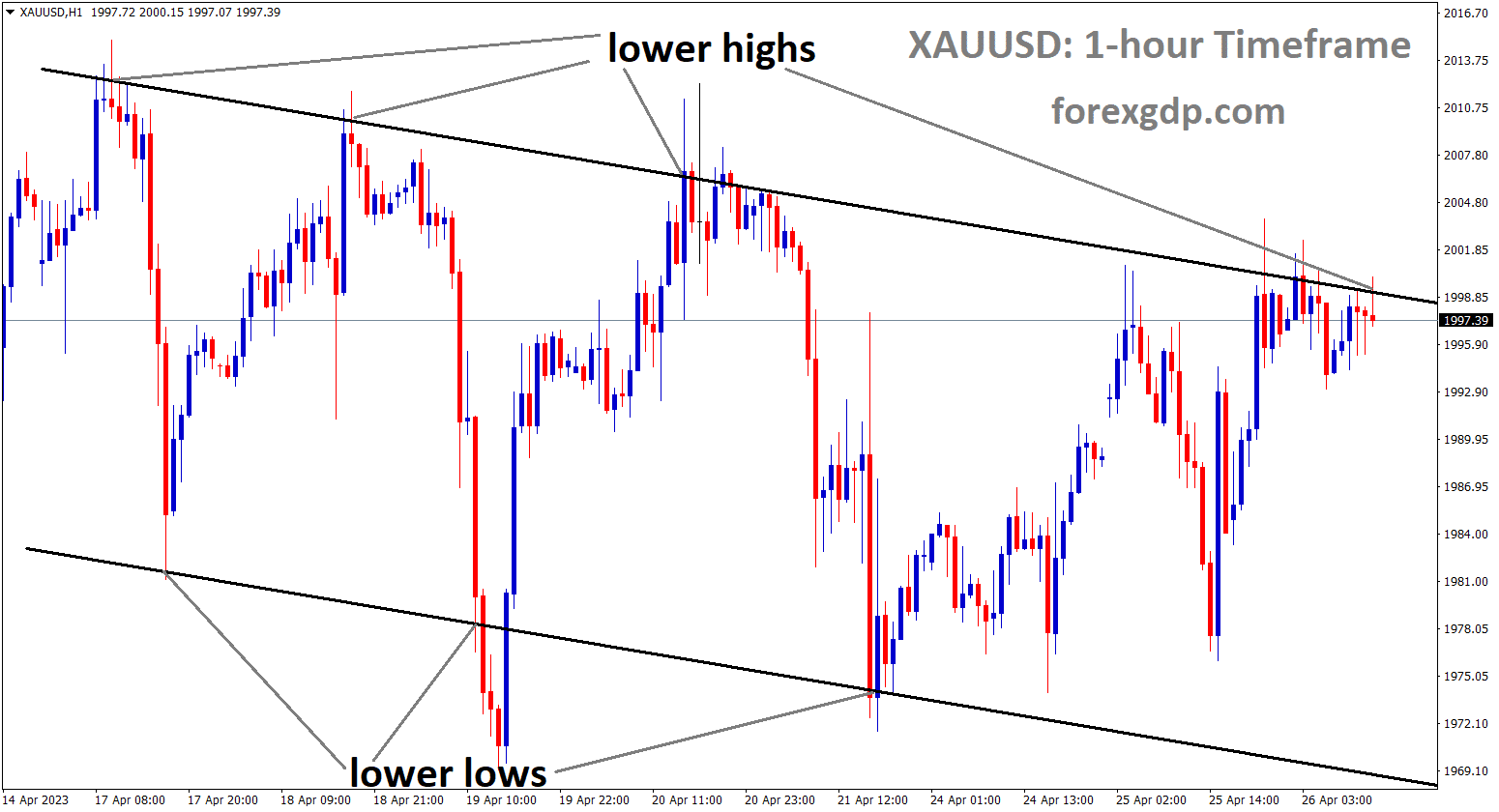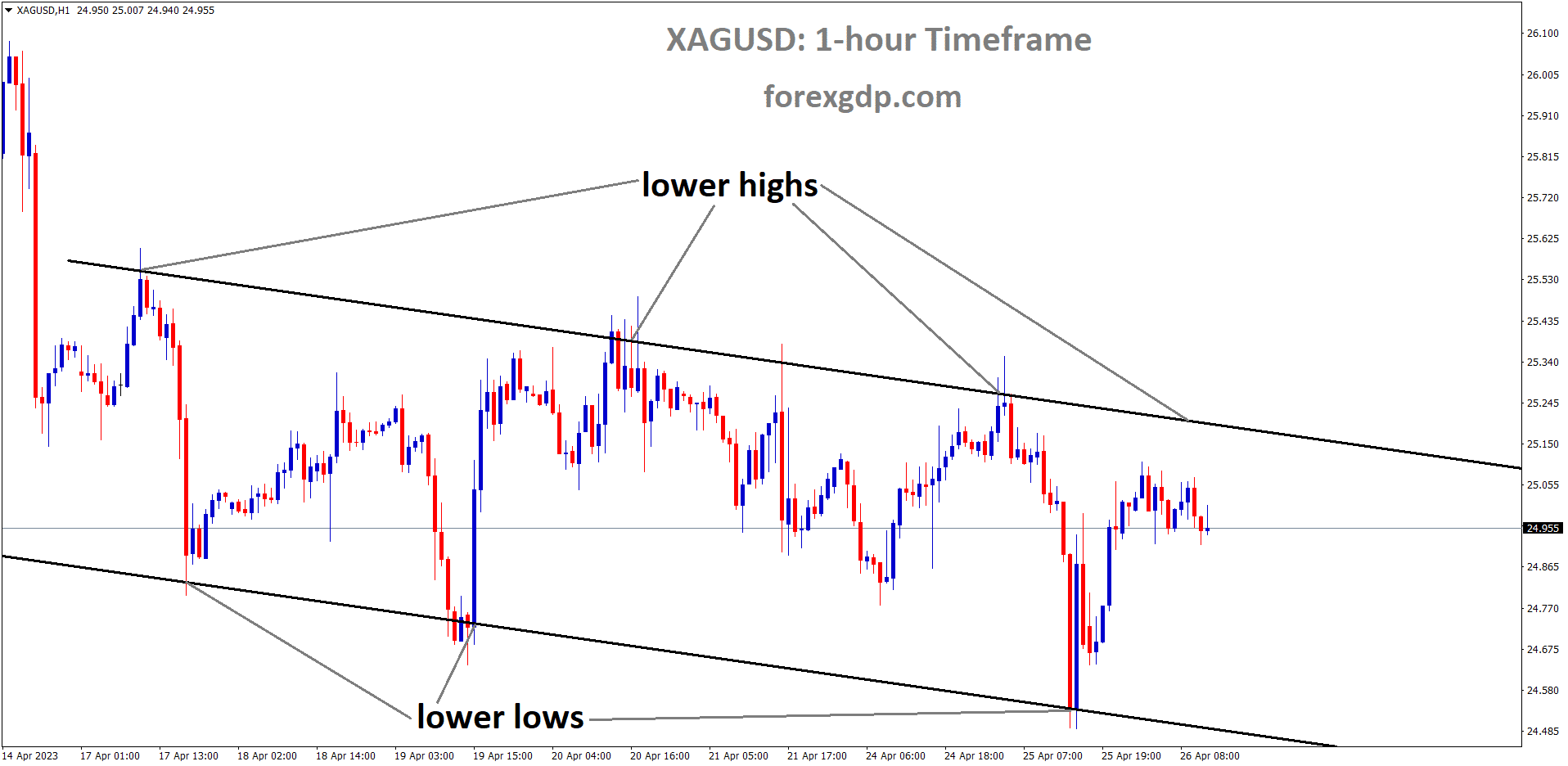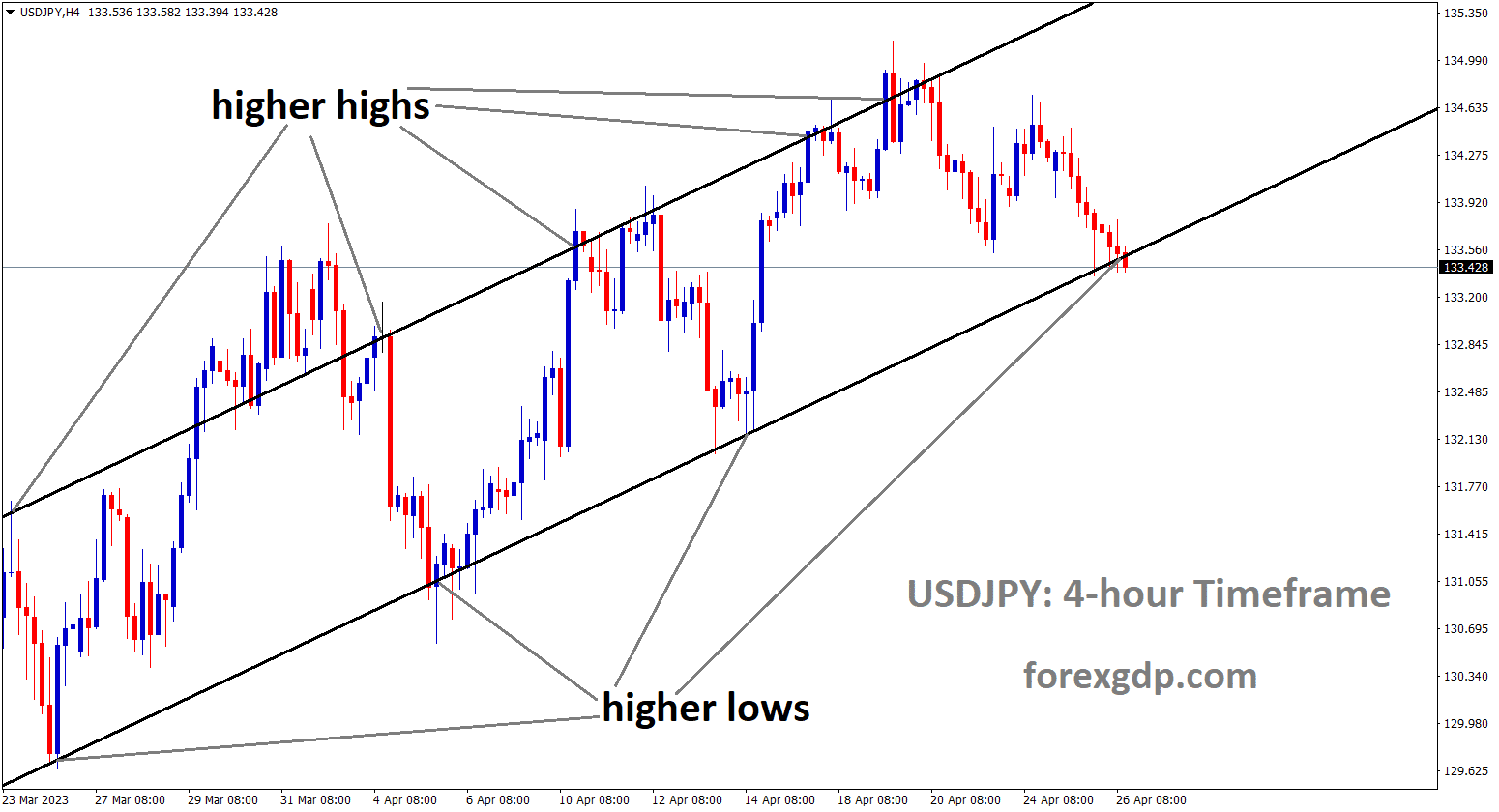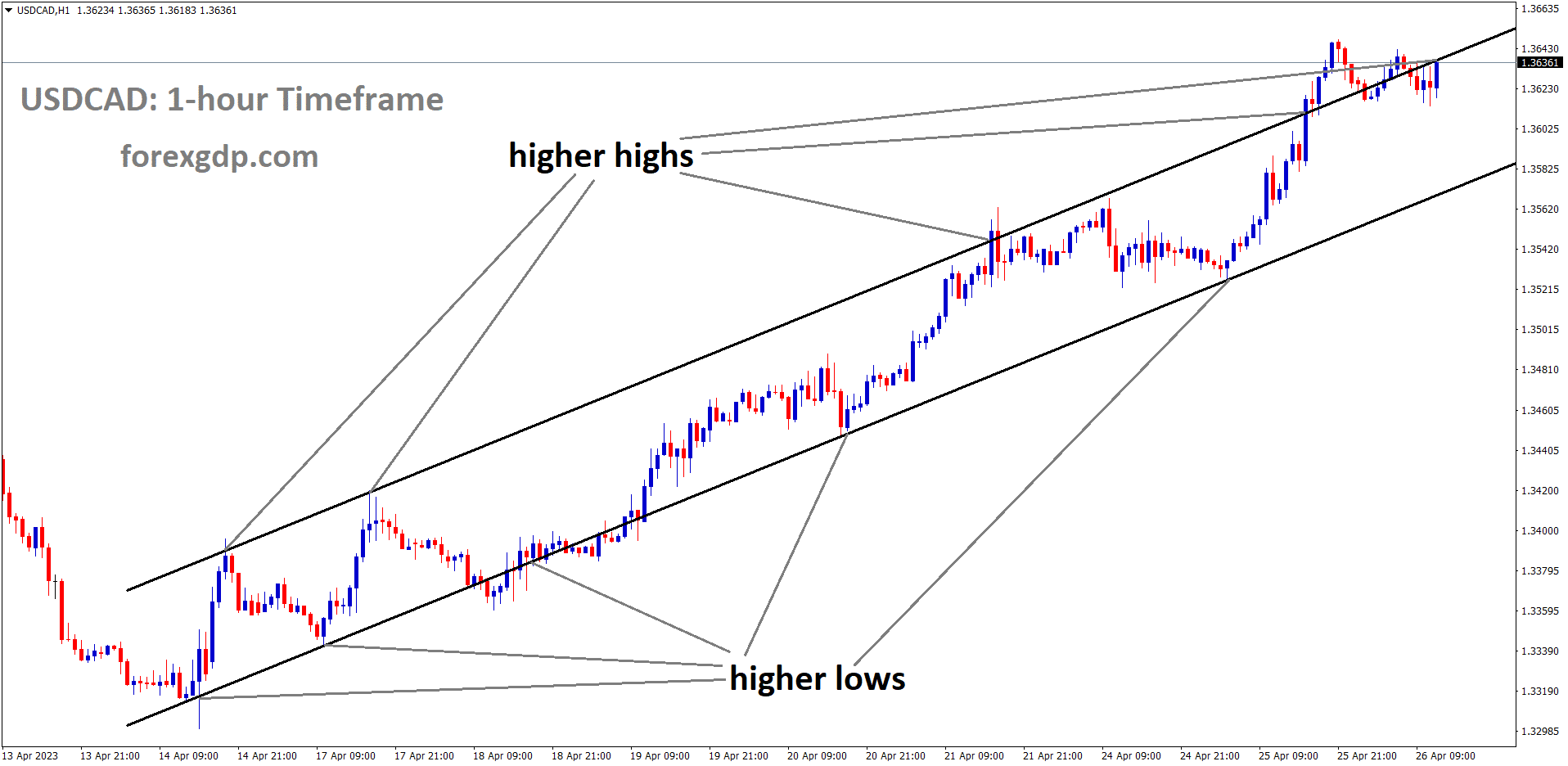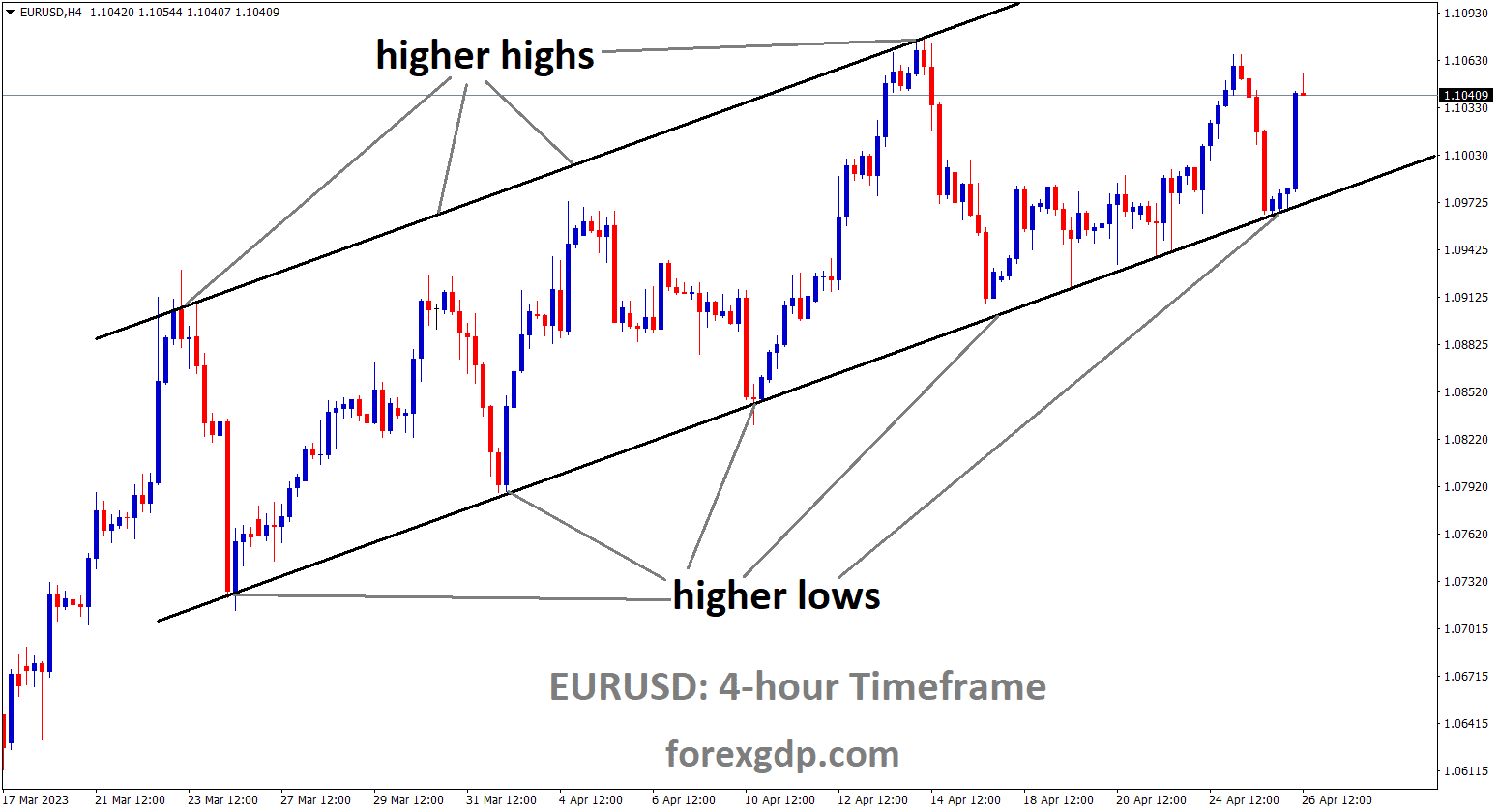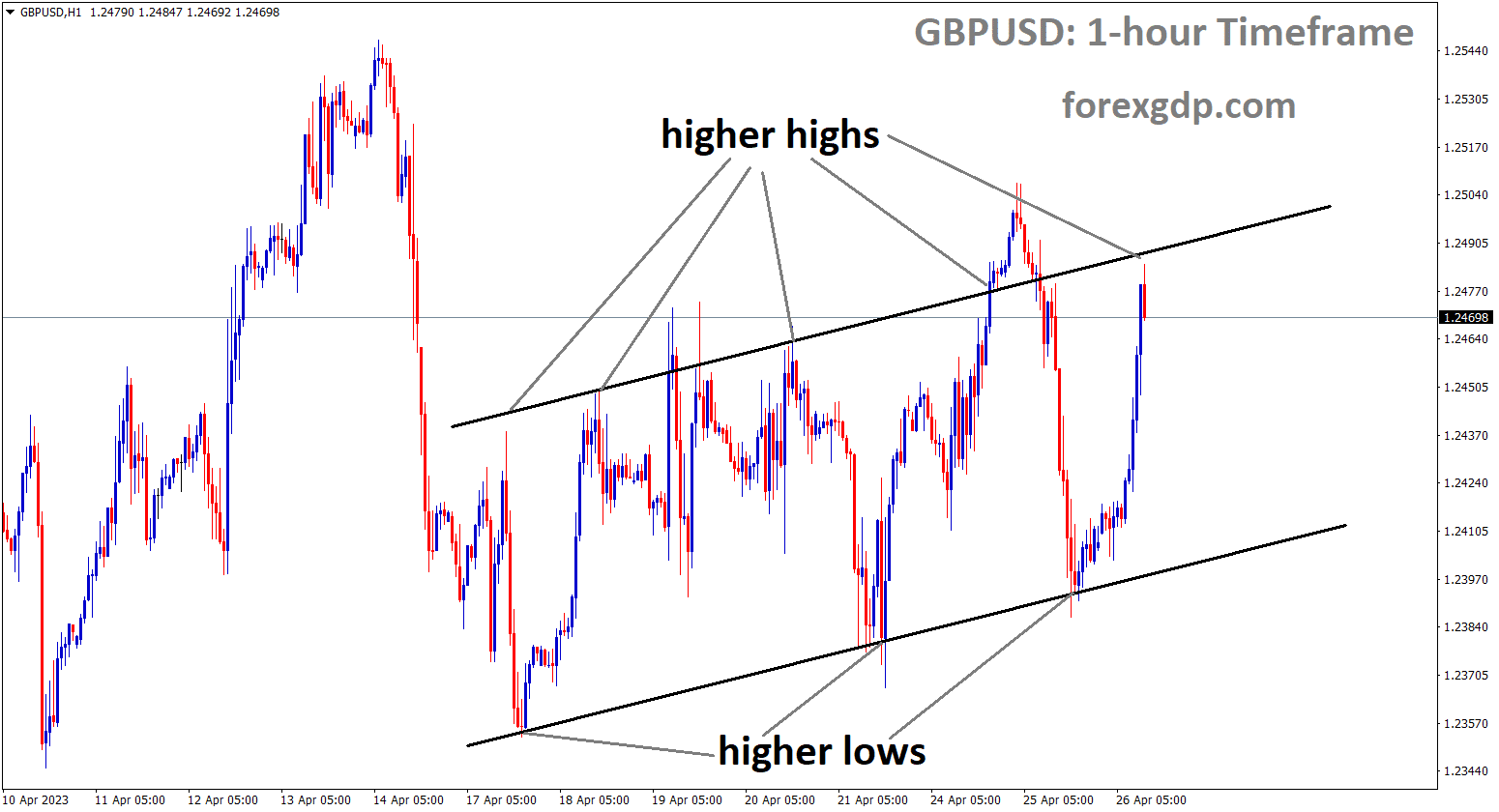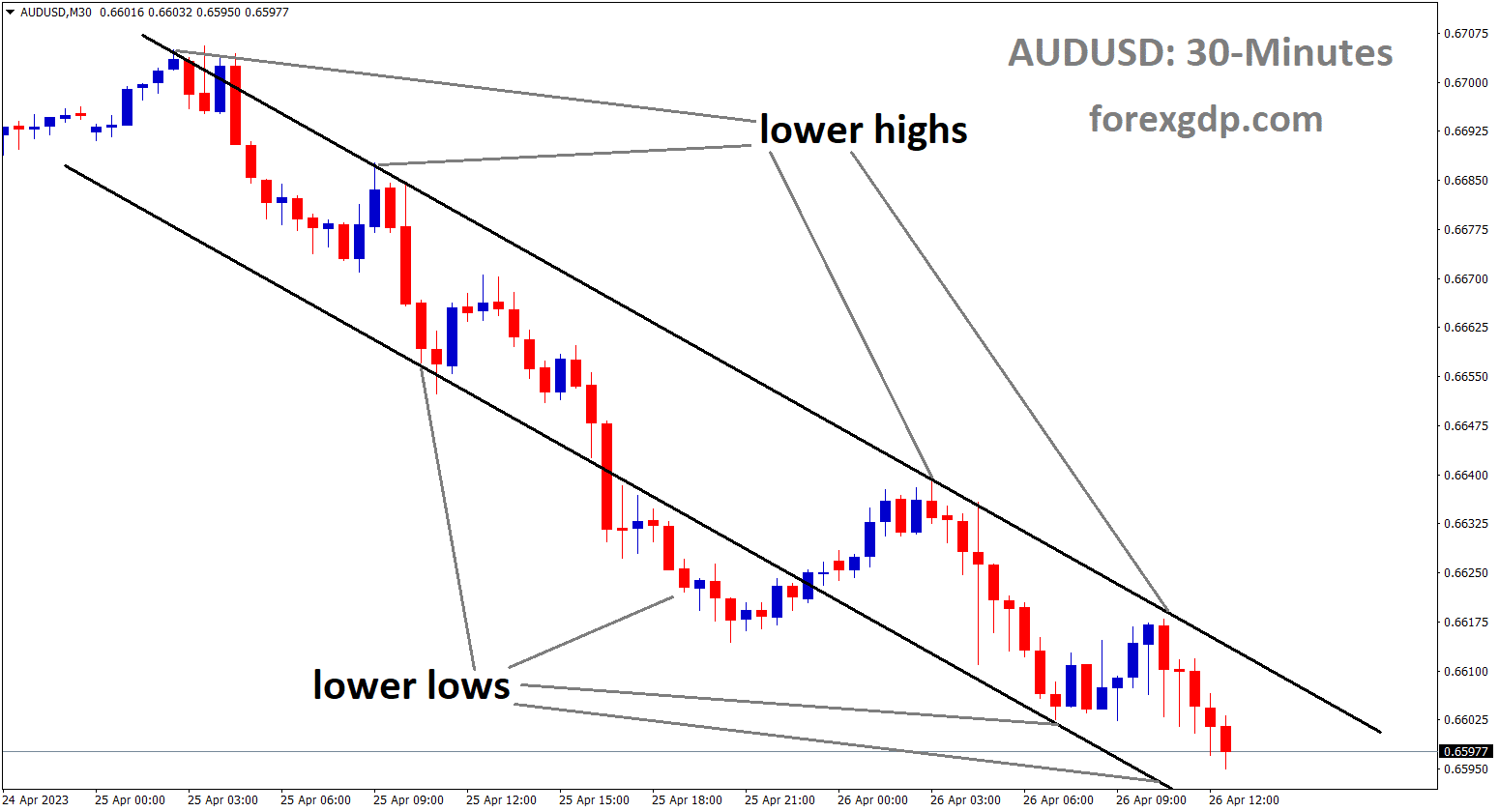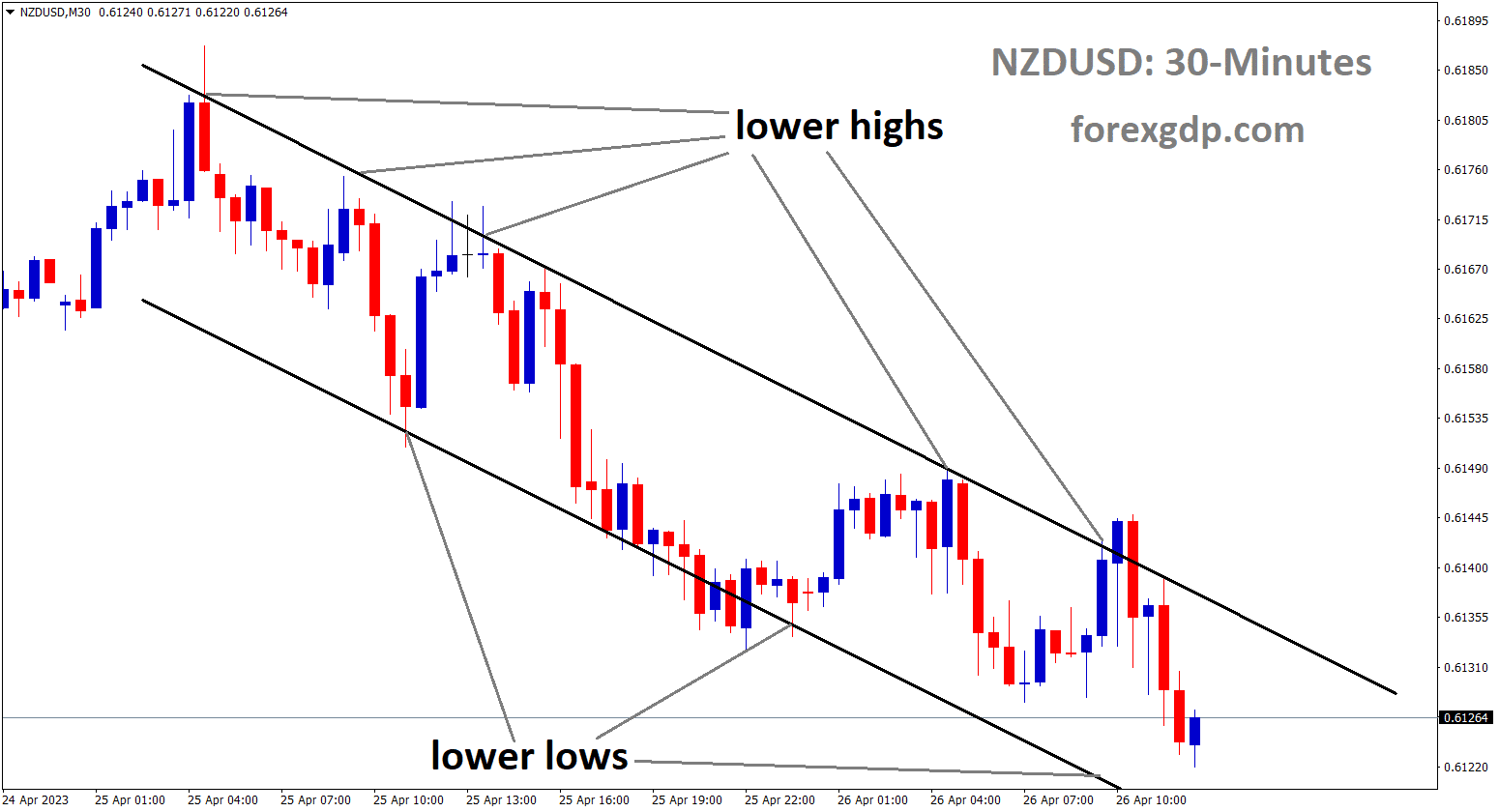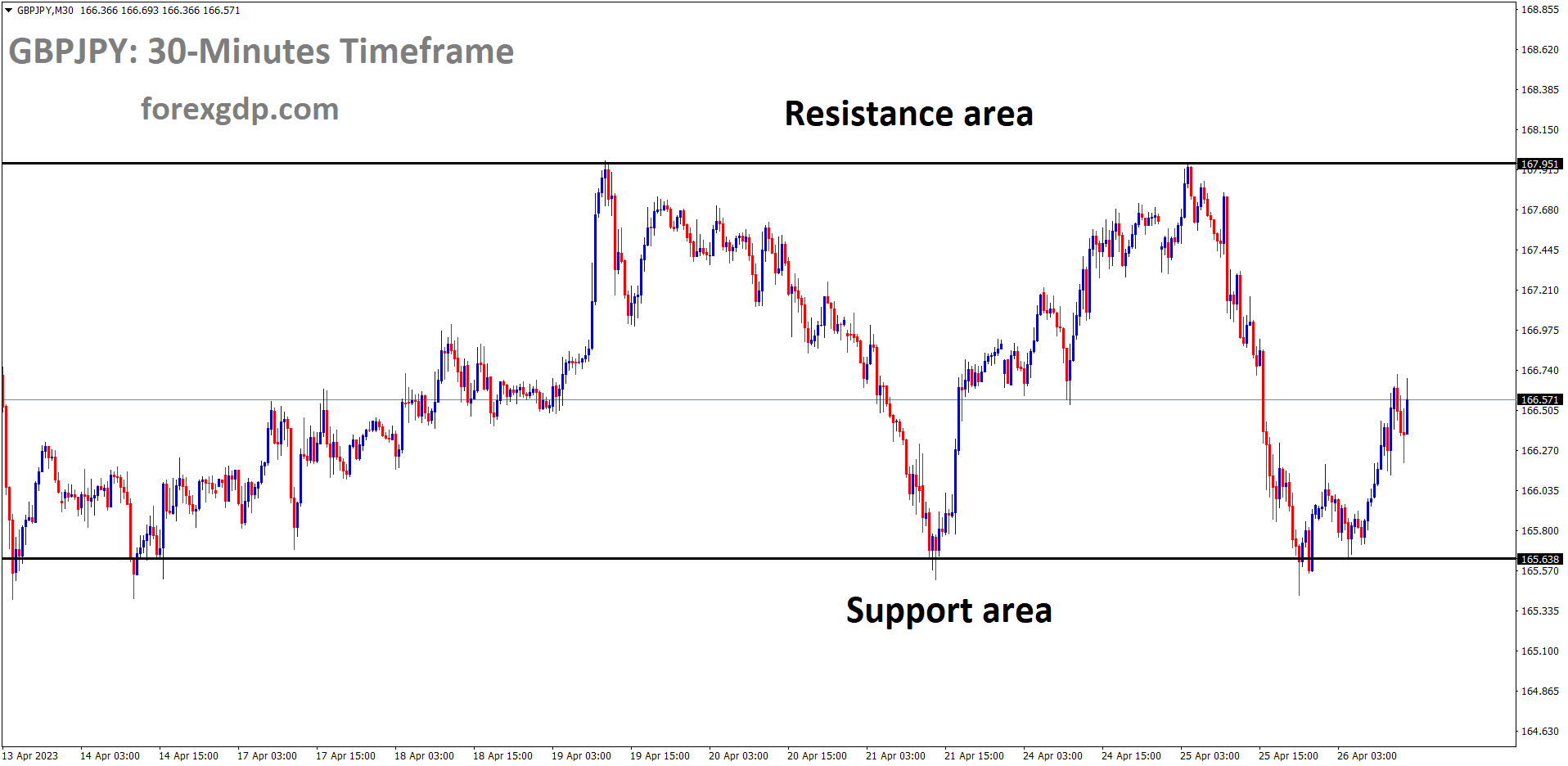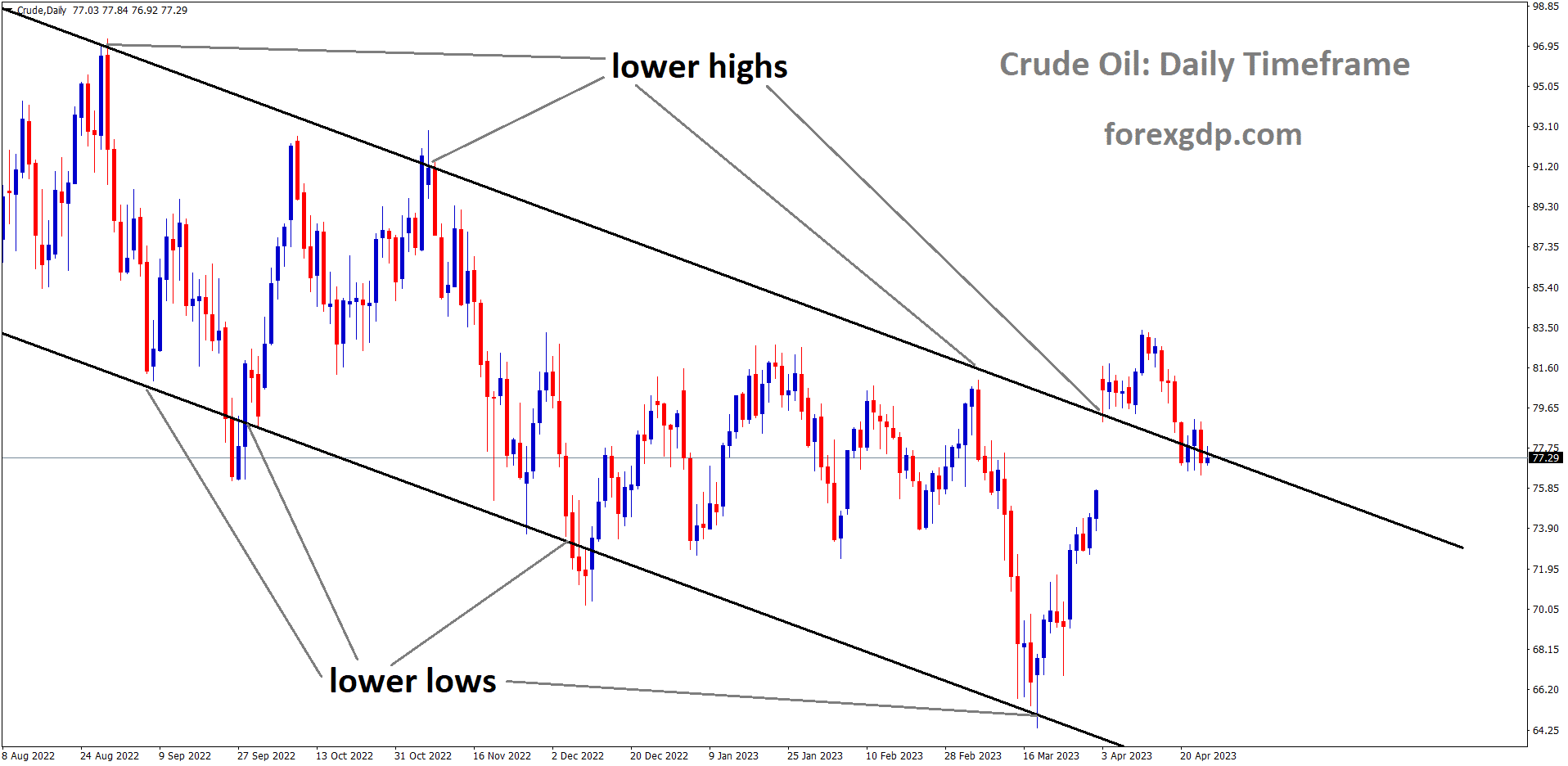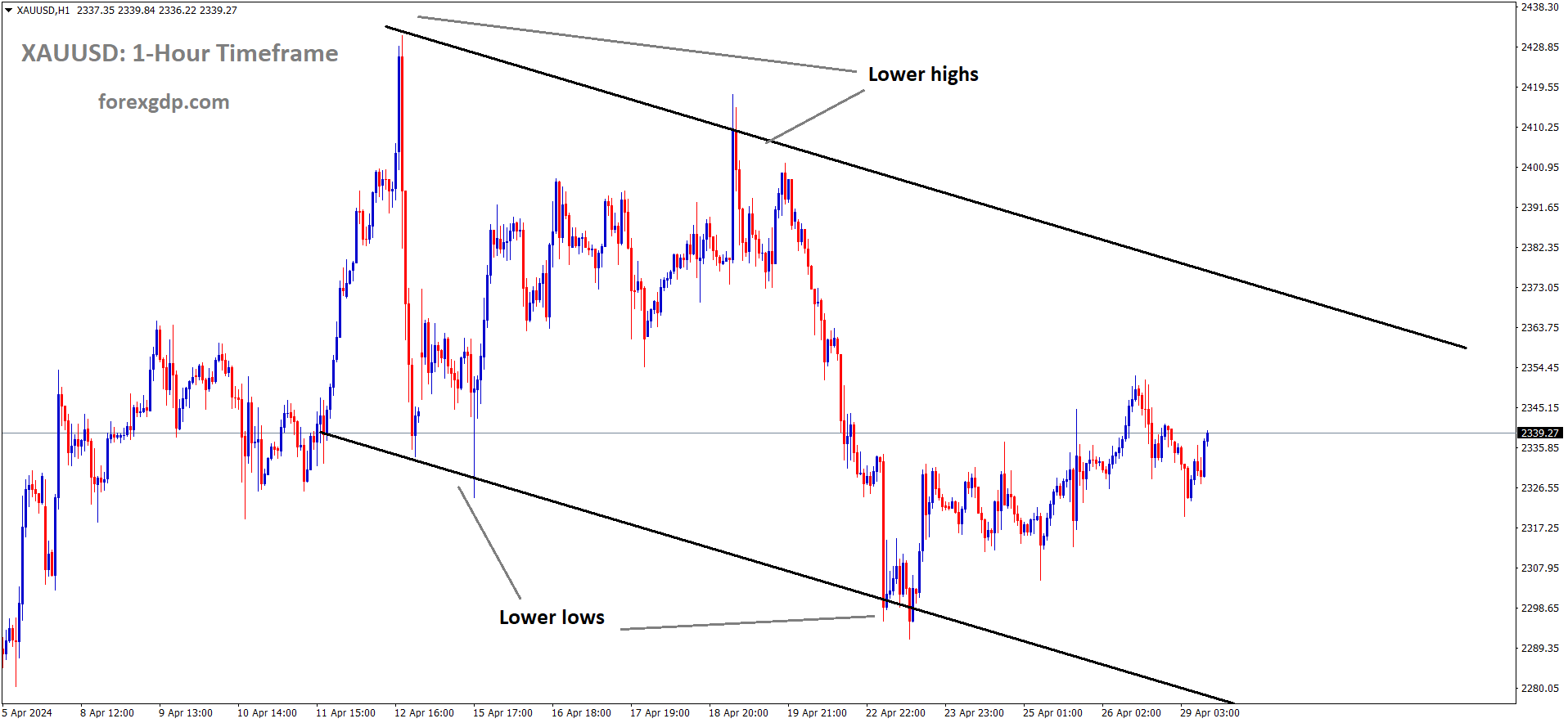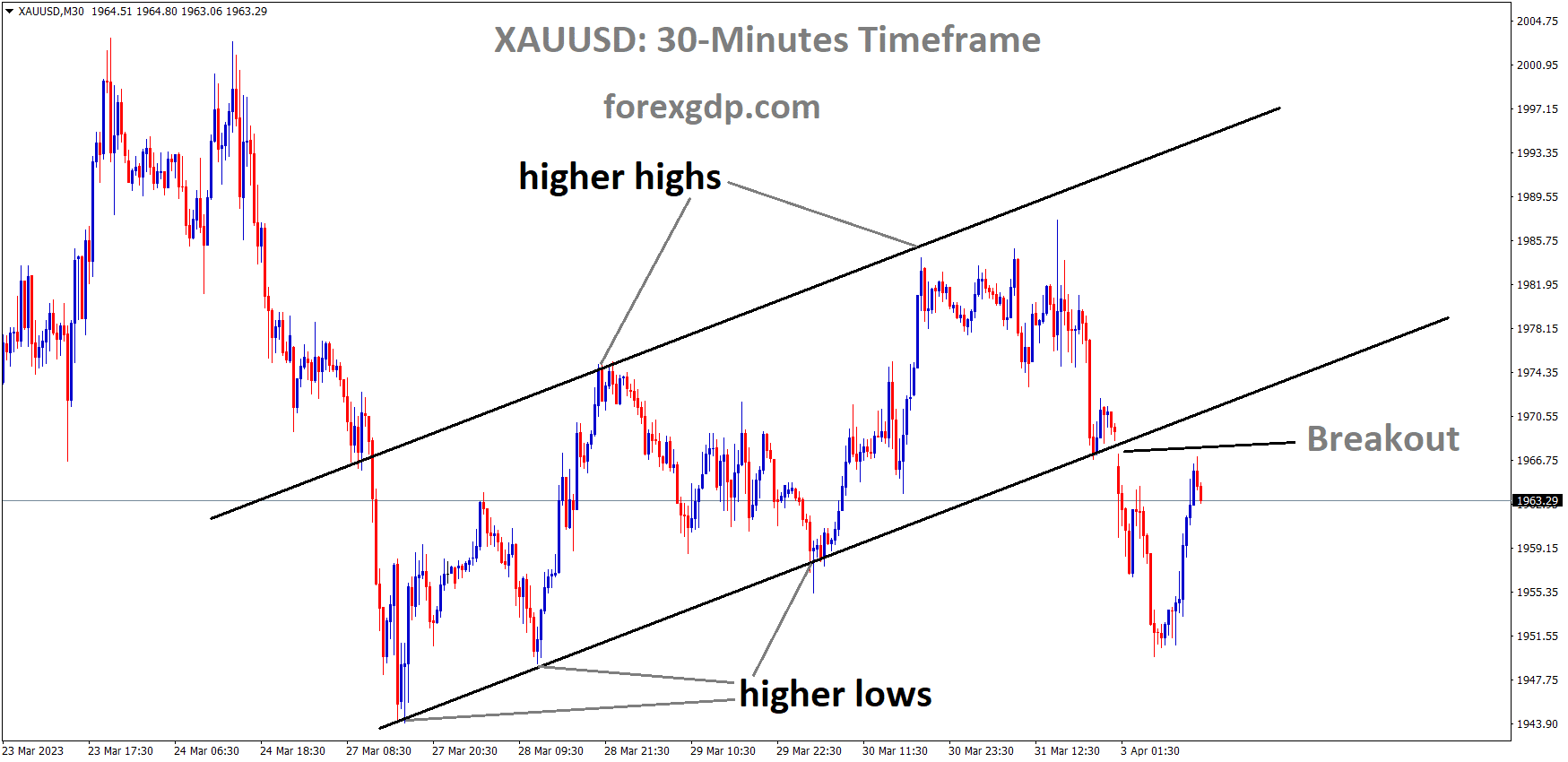GOLD Analysis
XAUUSD is moving in Descending channel and the market has reached the lower high area of the channel.
The gold price maintains a protective level around $1,995 as metal investors wait for new cues to support the two-day advance early on Wednesday. The market’s cautious optimism and anticipation of the Durable Goods Orders for March, a crucial indicator of the United States Gross Domestic Product for the first quarter, are causing the XAUUSD to struggle as a result. The S&P 500 Futures, which reflect the mood, increase by 0.5 percent while reversing the largest daily loss in a month, supported by positive tech earnings reported late Tuesday. Additionally, the US two-year bond coupons continue to be under pressure while the US 10-year Treasury bond yields prod a two-day decline. Despite this, the US Dollar Index drops to 101.70 the day after breaking a three-day decline.
SILVER Analysis
XAGUSD is moving in Descending channel and the market has reached the lower high area of the channel.
Speaking of the primary drivers, strong financial results from Microsoft and Alphabet along with US President Joe Biden’s threat to use the veto to prevent the US default further support the market’s measured confidence and cause a decline in the price of gold. According to the Washington Post, President Biden “threatened on Tuesday to veto legislation being pushed by House Republican leaders that would tie support for raising the debt ceiling to significant spending cuts, calling it a reckless effort to extract extreme concessions in exchange for the United States simply paying the bills it has already incurred.” Prior to this, the First Republic Bank’s fresh financial concerns, together with the US debt ceiling negotiations and mixed US data, agitated the market and fueled the XAUUSD run-up because of the metal’s demand as a safe-haven. Moving on, the performance of the XAU/USD pair in the short run prior to the US Q1 GDP will be determined by the US Durable Goods Orders for March, which are predicted to increase to 0.8% from -1.0% previously.
USDJPY Analysis
USDJPY is moving an Ascending channel and the market has reached the higher low area of the channel.
On Wednesday, the USDJPY pair continues in the red for the second straight day, despite managing to hold slightly above a one-week low hit the day before. During the early European session, the pair is trading near 133.50, losing more than 0.10% on the day. A number of opposing forces are at play. The USDJPY pair benefits from the Bank of Japan’s Kazuo Ueda’s dovish comments earlier this week, as well as a slight rebound in US equity futures, which undercut the safe-haven Japanese Yen. It is important to remember that the new Governor of the Bank of Japan stated on Monday that the central bank must continue its monetary easing programme because trend inflation is still below 2%. She also stated that the inflation estimates for the upcoming year must be very positive and near to 2% in order to contemplate changing the yield curve control.However, amid further US Dollar selling spurred by the recent decline in US Treasury bond yields, the upside for the USDJPY pair is now restrained. In reality, despite growing anxieties about the regional banking industry, the potential for an impending recession, and concerns about the US debt ceiling, the yield on the benchmark 10-year Treasury bonds had its worst decrease since March. As a result, the Greenback is unable to benefit from the overnight substantial gains.
In addition, traders might avoid from making risky directional bets and decide to wait it out until the significant US macro data/central bank event risk has passed. This week, the Advance US Q1 GDP print will be released on Thursday. This will be followed by the US Core PCE Price Index, the Fed’s favoured inflation indicator. This could provide the USDJPY pair a new boost and help define its trajectory in the near term, coupled with the critical BoJ monetary policy meeting on Friday. The US Durable Goods Orders report, which is scheduled to be released later during the early North American session, will serve as a guide for traders on Thursday. This could affect the USD price dynamics and give the USDJPY pair some momentum, along with the US bond yields. In addition, the general risk attitude should help provide short-term chances around the major.
USDCAD Analysis
USDCAD is moving an Ascending channel and the market has higher high area of the channel.
As it moves to 1.3620-30 in the early hours of Wednesday, USDCAD struggles to maintain its largest daily gains in seven weeks. The biggest export from Canada, oil, has just had a break from its downward trend, and the market has been consolidating in preparation for the important US Durable Goods Orders for March. However, new worries about bank failures and the US debt ceiling expiration kept buyers of the Loonie pair optimistic, especially given the Bank of Canada’s significantly more dovish stance than that of the Federal Reserve. The previous day, the US Dollar benefited from the general risk-off sentiment and the largely positive US statistics, pushing the Loonie pair to its best levels in a month. Having said that, news stories about First Republic Bank and the US debt ceiling debate stoked risk aversion the day before, which supported demand for the US Dollar as a safe haven and pulled down the price of WTI.
It’s important to note that WTI crude oil is still under pressure at around $77,000 after Tuesday’s decline to its lowest levels in three weeks. The recent slowdown in the black gold’s further decline may be attributed to the sluggish markets and cautious atmosphere prior to the important US data and weekly Oil inventories from the US Energy Information Administration. Speaking of risks, First Republic Bank’s underwhelming quarterly reports along with the executives’ refusal to take questions and no earnings outlook combined to cause a new wave of banking concerns, causing Wall Street to close in the red and US Treasury bond yields to stay low. The major central banks still made an effort to regain market trust by limiting the US Dollar activities that were started during the initial financial crisis. The major central banks in the world are beginning to reduce the frequency of their dollar liquidity operations with the U.S. Federal Reserve starting in May, delivering the strongest indication yet that the turmoil in the financial markets last month has largely subsided.
On the other hand, when the present cap expires in June, worries about the US debt ceiling rising weigh on investors’ willingness to take risks. That said, US Treasury Secretary Janet Yellen warned that failure by Congress to raise the government’s debt ceiling–and the resulting default–would trigger an “economic catastrophe” that would send interest rates higher for years to come, per Reuters. It’s important to note that the USDCAD purchasers benefited from the generally positive US data. The Consumer Confidence Index for April from the US Conference Board dipped slightly from 104.0 on Tuesday to 101.3. According to additional information in the magazine, the Consumer Expectations Index fell to 68.1 from 74 previous readings during the aforementioned month, while the Present Situation Index moved up to 151.1 from 148.9 earlier. The predictions for consumer inflation over the next year also decreased, from 6.3% in March to 6.2% in April. In a different release, the US New Home Sales rose to 0.683M MoM in March versus 0.634 expected and 0.623M revised prior while the S&P/Case-Shiller Home Price Indices and Housing Price Index both rose past market forecast to 0.4% and 0.5% respectively for February.
EURUSD Analysis
EURUSD is moving an Ascending channel and the market has rebounded from the higher low area of the channel.
During Wednesday’s European session, the Euro (EUR) trades again over 1.1000 against the US Dollar (USD). After Tuesday’s market turmoil, when the pair dropped more than 100 pips as a result of an unexpected rise in USD strength, the pair has stabilised. However, it’s also plausible that hedge funds rushing to cover a big $10 billion failed US Treasury bond short contributed to the move. The broad agreement is that the rise was driven by safe-haven flows because of the US recession and banking fears. Despite the sell-off on Tuesday, the underlying trend is still upward, and longs are more likely to succeed than shorts. Due to safe-haven flows caused by recession and financial crisis fears, the US Dollar increased on Tuesday. Fears of a banking crisis have been revived by reports that struggling lender First Republic Bank is considering selling $100 billion worth of loans—more than half of its loan book—to strengthen its balance sheet. Higher-than-expected new home sales were overshadowed by lower-than-expected US consumer confidence numbers for April, which were seen as indicators of a potential US recession. In spite of this, US T-bond yields, particularly those with a two-year maturity, sharply declined as investors reevaluated the prospect that the Federal Reserve would start lowering rates earlier than had been anticipated.
ECB members’ generally hawkish remarks have helped the euro. We must wait for core inflation and wage growth to decline before we can pause, according to Pierre Wunsch, president of Belgium’s Banque Nationale. Philip Lane, the ECB’s senior economist, has also publicly stated that interest rates will increase at the May 4 meeting, but whether they do so further depends on the facts. The Irishman had previously stated that a lot depends on the status of Eurozone banks as determined by the ECB’s Bank Lending Survey, which will be issued on May 2, as well as the April flash HICP inflation data, which will also be released on that day. But strong first-quarter results by European banks, driven by increased interest margins, imply that the BLS would provide a positive picture. For instance, Banco Santander’s most recent Q1 profits surpassed profit forecasts of 2.4 billion with 2.57 billion. Recently, ECB President Christine Lagarde stated that there is still more interest rate hikes to come from Frankfurt. Due to the two-week period before the Federal Reserve (Fed) meeting on May 4 during which they are not permitted to comment, the US Dollar is at a disadvantage. Bullard of the St. Louis Fed was aggressive before the blackout, stating that he anticipates further rate increases due to persistent inflation and exaggerated recession fears. Wednesday’s March Durable Goods Orders data release, which is released at 12:30 GMT, is crucial for the US dollar. German Consumer Confidence Gfk in May, which came out at -25.7 and surpassed the prior result by 2 bps, was the primary release for the Euro.
GBPUSD Analysis
GBPUSD is moving an Ascending channel and the market has reached the higher high area of the channel.
On Wednesday, the GBPUSD pair regains bullish momentum and undoes a significant portion of the previous day’s retracement slip from a one-week high, hovering just above the psychological level of 1.2500. Spot prices are currently trading in the 1.2455–1.2460 range, up more than 0.40% for the day, building on the steady intraday rise through the early hours of the European session. A major reason driving the GBPUSD pair is the US Dollar’s inability to profit from the overnight strong run up and subsequent resurgence of selling pressure. Bets on an impending rate drop by the Federal Reserve (Fed) later this year increase in light of new worries over the regional banking sector crisis, the potential for an impending recession, and concerns regarding the US debt ceiling. This in turn caused a sharp overnight decrease in the yields on longer-term US Treasury bonds, which is still putting pressure on the greenback.
In addition, a slight rebound in US stocks puts more pressure on the safe-haven dollar, which continues to underpin the GBP/USD pair’s intraday upward movement. The British pound also appears to benefit from speculation that the Bank of England (BoE) would raise interest rates by another 25 basis points in May. Stronger UK consumer inflation and wage growth data released last week increased bets, which favour bulls and increases the likelihood of another intraday upward rise for the major.
Traders now turn their attention to the US economic calendar, which includes the publication of Durable Goods Orders data later during the early North American session, in the lack of any pertinent market-moving macro data from the UK. The US Core PCE Price Index, the Fed’s preferred inflation gauge, will be released on Friday, and the Advance US Q1 GDP data will be released on Thursday. This will be crucial in determining the near-term USD price dynamics and the following leg of the GBPUSD pair’s directional motion.
AUDUSD Analysis
AUDUSD is moving Descending channel and the market has reached the lower low area of the channel.
The AUDUSD pair continues to experience selling pressure for the second straight day on Wednesday, compounding the previous day’s severe losses. Through the first half of the European day, the pair holds its offered tone and is currently trading around the 0.6600 level, which is its lowest level since mid-March. After the Australian Bureau of Statistics reported that the headline CPI decreased from 1.9% to 1.4% during the March quarter, marking the weakest growth since late 2021, the Australian Dollar fell across the board. Additionally, the annual CPI slowed down from 7.8% to 7.0%, indicating that inflation may have reached its peak. In addition, the Reserve Bank of Australia faces less pressure to increase interest rates as a result of the softer core CPI, which pushes the AUDUSD pair lower. On the other side, the US Dollar experiences some fresh selling pressure, which significantly reduces the overnight strong gains and prevents bearish traders from making risky bets on the AUDUSD pair. Bets on an impending rate drop by the Federal Reserve later this year increase due to new worries about the regional banking sector crisis, the potential for an impending recession, and concerns about the US debt ceiling, all of which weigh on the US dollar.
In addition, a slight rebound in US equities futures puts more downward pressure on the safe-haven dollar and helps to contain losses for the AUDUSD pair, at least temporarily. The aforementioned fundamental, however, continues to appear to be biassed in favour of bearish traders and promotes the possibility of further losses. As a result, it appears that a following decline towards testing the YTD low, in the range of 0.6570–0.6575, is very likely. The US Durable Goods Orders data, which is due later during the early North American session, is currently being watched by market participants for a new impetus. The US Q1 GDP data is due out on Thursday, and the Fed’s favourite inflation indicator, the Core PCE Price Index, is due out on Friday. The significant US inflation data will affect short-term USD price dynamics and aid in determining the direction of the next leg of the AUDUSD pair’s directional move.
NZDUSD Analysis
NZDUSD is moving in Descending channel and the market has reached the lower low area of the channel.
Following a three-day low of 0.6133 in the Tokyo session, the NZDUSD pair has shown a retracement movement to roughly 0.6147. As the Reserve Bank of New Zealand’s plan to relax loan-to-value ratio regulations has delivered an approach of consideration of easing monetary policy, the Kiwi asset may experience a completion of retreat move sooner. The RBNZ has given the qualitative easing proposal some thought, noting that the lower risks to financial stability may be causing current limitations to unnecessarily reduce efficiency. After a corrective fall to close to 101.80, the US Dollar Index has begun to show signs of recovery. Anxiety about the Federal Reserve’s (Fed) interest rate policies is starting to manifest itself, which increases demand for safe-haven assets like the US Dollar.
GBPJPY Analysis
GBPJPY is moving in Box pattern and the market has rebounded from the support area of the pattern.
Regardless of whether the markets expect the BoJ to maintain current interest rates, they will likely be keenly monitoring this decision. This is so because Kazuo Ueda, the BoJ’s new governor, is making his first judgement about interest rates. Any hints as to when Ueda would start tightening monetary policy can be found in the commentary that follows the interest rate decision. It’s not unlikely that Ueda might prepare some very brief non-committal comments that speak to this on Friday while standing firmly behind his preference for maintaining the current yield curve control in the short to medium term, which he has reiterated at every outing since taking control of the central bank. The BoJ will likely try to prepare markets far in advance.
Crude Oil Analysis
Crude oil is moving in Descending channel and the market has reached the lower high area of the channel.
Energy security would be at risk without OPEC and its partners, according to Russian Deputy Prime Minister Alexander Novak. Global changes in the energy markets were caused by an unprecedented embargo on Russian oil, equipment imports, and the installation of price restrictions. The overall equilibrium between the supply and demand for oil has not changed. The importation of liquefied natural gas became more important for Europe. The Russian energy sector has proven to be resilient, and we’ve discovered new logistical channels. 20% of the Russian oil that is initially shipped to Europe is diverted to other markets, such Asia. OPEC+ is successful. We at OPEC+ do not control oil prices. The 24 nations of OPEC+ can have trouble agreeing on things at times.
Don’t trade all the time, trade forex only at the confirmed trade setups.
Get Live Free Signals now: forexgdp.com/forex-signals/

